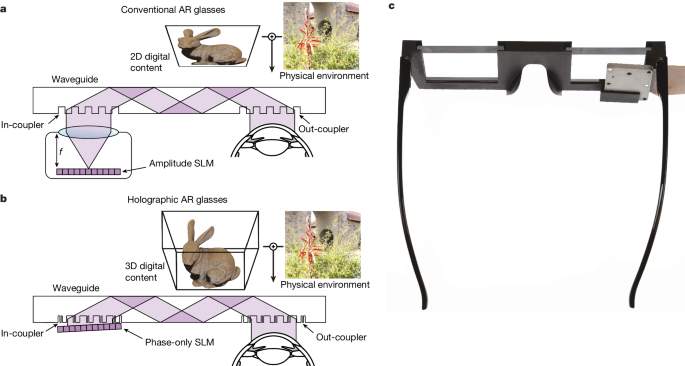Compact Full-Color 3D Holographic Augmented Reality Displays Enabled by Metasurface Waveguides and AI-Driven Holography
核心概念
A compact holographic augmented reality system that uses inverse-designed full-color metasurface gratings, a dispersion-compensating waveguide geometry, and AI-driven holography algorithms to deliver vibrant, 3D AR content in a wearable device.
要約
The content describes the development of a novel holographic augmented reality (AR) system that overcomes the limitations of traditional AR displays. The key innovations include:
Inverse-designed full-color metasurface gratings: These metasurface gratings eliminate the need for bulky collimation optics between the spatial light modulator and the waveguide, enabling a compact device form factor.
Dispersion-compensating waveguide geometry: The unique waveguide design, combined with the metasurface gratings, allows the system to present vibrant, full-color, 3D AR content.
AI-driven holography algorithms: The authors develop an innovative image formation model that combines a physically accurate waveguide model with learned components, automatically calibrated using camera feedback. This enables unprecedented visual quality in the prototype.
The co-design of the nanophotonic metasurface waveguide and the AI-driven holographic algorithms represents a significant advancement in creating visually compelling 3D AR experiences in a compact wearable device.
Full-colour 3D holographic augmented-reality displays with metasurface waveguides - Nature
統計
Emerging spatial computing systems can seamlessly superimpose digital information on the physical environment observed by a user, enabling transformative experiences across various domains, such as entertainment, education, communication and training.
引用
"Our unique co-design of a nanophotonic metasurface waveguide and artificial-intelligence-driven holographic algorithms represents a significant advancement in creating visually compelling 3D AR experiences in a compact wearable device."
抽出されたキーインサイト
by Manu Gopakum... 場所 www.nature.com 05-08-2024
https://www.nature.com/articles/s41586-024-07386-0
深掘り質問
How can the AI-driven holography algorithms be further improved to enhance the visual quality and realism of the 3D AR content?
To enhance the visual quality and realism of 3D AR content, AI-driven holography algorithms can be further improved in several ways. Firstly, increasing the complexity and accuracy of the holographic algorithms can lead to more realistic rendering of virtual objects in the physical environment. This can involve refining the algorithms to better simulate light interactions, shadows, and reflections, resulting in a more immersive experience for users. Additionally, incorporating machine learning techniques to continuously train the algorithms based on user feedback and environmental data can help adapt the AR content in real-time, improving its visual quality and responsiveness. Furthermore, optimizing the algorithms to work seamlessly with the metasurface waveguides and waveguide geometry can ensure that the holographic projections are aligned correctly and appear natural within the user's field of view. By refining these aspects, AI-driven holography algorithms can significantly enhance the visual quality and realism of 3D AR content.
What are the potential challenges and limitations in scaling up the production and commercialization of these compact holographic AR displays?
Scaling up the production and commercialization of compact holographic AR displays may face several challenges and limitations. One major challenge is the cost associated with manufacturing the intricate metasurface gratings and dispersion-compensating waveguide components required for these displays. The production of these nanophotonic elements at scale may require specialized fabrication processes and materials, leading to higher production costs. Additionally, ensuring the reliability and consistency of these components across mass production can be a challenge, as any variations or defects in the metasurface gratings or waveguides can impact the performance of the AR displays. Another limitation is the current state of consumer readiness and acceptance of AR technology, which may affect the market demand for these compact holographic AR displays. Educating consumers about the benefits and applications of AR technology and addressing concerns related to privacy and usability will be crucial in driving adoption and commercial success. Furthermore, regulatory hurdles and standards compliance in different regions can also pose challenges in scaling up production and commercialization efforts.
How might the integration of this holographic AR technology with other emerging technologies, such as brain-computer interfaces or haptic feedback systems, lead to even more immersive and interactive spatial computing experiences?
Integrating holographic AR technology with other emerging technologies, such as brain-computer interfaces or haptic feedback systems, can significantly enhance the immersive and interactive nature of spatial computing experiences. By incorporating brain-computer interfaces, users can interact with the AR content using their thoughts or neural signals, enabling more intuitive and hands-free control of virtual objects. This can lead to a more seamless and natural user experience, where actions and commands are executed directly from the user's brain activity. Additionally, integrating haptic feedback systems can provide tactile sensations and physical interactions with virtual objects, enhancing the sense of presence and realism in the AR environment. Users can feel textures, vibrations, or resistance when interacting with virtual elements, further blurring the line between the physical and digital worlds. By combining holographic AR technology with these advanced interfaces and feedback systems, spatial computing experiences can become more engaging, immersive, and interactive, opening up new possibilities for entertainment, education, training, and communication.
0
